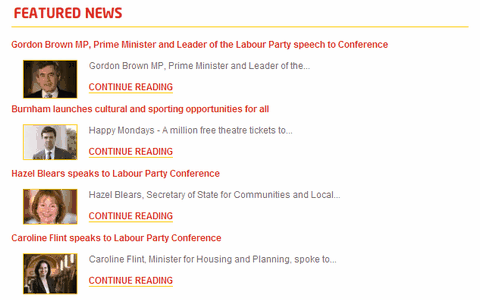Labour MP for Newport West, Paul Flynn has apparently ‘been stripped of a Parliamentary allowance for making fun of other MPs on his blog‘, if you read today’s BBC piece on the subject. Flynn himself tells the story slightly differently, on said blog.
I’ve had a similar run-in with my own MP, Newbury’s Richard Benyon (Con). Back in September, the first posting on his new blog made some undeniably party-political comments: he talked about Labour being in a state of ‘desperation’, and his boss David Cameron ‘[continuing] to look like a Prime Minister in waiting’.
Good old political knockabout, nothing wrong with that… except his website proudly declared on every page that it is ‘paid for from his Communications Allowance’, which is explicitly not to be used ‘to promote, criticise or campaign for or against anyone seeking election’. To his credit, he made swift if superficial amends: I don’t see from a technical viewpoint how it’s possible for www.richardbenyon.com/blog ‘not [to be] connected to www.richardbenyon.com’.
The point is this: as both Flynn and Benyon have said, playing by the Parliamentary allowance’s rules would have meant a ‘totally non-political, fence sitting and boring’ blog. With the cost of setting up a basic blog being so low, indeed zero in most cases, it doesn’t make sense to take a chance with the ‘Byzantine complexity of the House of Commons rules’ (to quote Mr Benyon, although frankly I’m not buying that; the rules couldn’t be much clearer).
If you’re an MP, and you want to start a blog, here are the facts:
- Most political blogs live on Blogger.com, a hosted service owned by Google, and free of charge. It’s not the most sophisticated platform in the world, but it does allow you total freedom to customise your pages… if you so wish. It’s good enough for Guido Fawkes and Iain Dale, generally seen as the #1 and #2 in the UK; they’ve gone to considerable lengths to design their sites. Others, like Lynne Featherstone, John Pugh, David Jones or Andy Love really haven’t.
- Personally, I find WordPress.com a better blogging tool; but in its free, hosted incarnation, it’s limited in its scope for (full-on) customisation. See Tom Harris‘s top-rated blog, or the Lords Of The Blog group effort.
- But there are other free alternatives. Adrian Sanders runs his blog on MySpace – hey, why not? Tory MEP Daniel Hannan has a blog on the Telegraph‘s website; and whilst his is technically on the ‘columnists’ side of the fence, rather than the ‘public’ my.telegraph.co.uk service, there’s nothing to stop you doing that either. It’s not ideal, but maybe it suits you and your situation.
- If you want extra functionality, extra control or extra customisation, you’re looking at spending some money – but frankly, it needn’t be more than the price of a (very modest) dinner for two. Typepad used to be the service of choice for those who wanted to take things more seriously; their ‘pro’ service costs £75 a year, and gives you all the customisation and room for expansion you’re likely to need. Paul Flynn‘s site lives there, as does ConservativeHome, and the blogs of lobby journalists Benedict Brogan and Paul Waugh (among others).
- These days, the (generally) preferred option – certainly in these parts! – is to download and run your own copy of WordPress. It’s free, and it’s the best; but you’ll need to pay a few quid to put it somewhere – say £22.99 a year from Eukhost; and running it yourself does take some effort. Tom Watson, John Redwood and Richard Benyon use it, as does the remarkably popular PoliticalBetting.com; but for a simple blog, it’s probably overkill. When you want to do something more, though, it’s perfect: ask Gordon Brown, Nick Clegg and Jim Murphy.
There’s absolutely no shame in using the free options; and if you decide you need more, for whatever reason, you’re looking at a couple of hundred quid, tops… with most of that going to the friendly geek who sets it up for you. I dare say many MPs could find that kind of sum down the back of their sofa.
Spending a portion of your Communications Allowance on a blog is just The Wrong Thing To Do. And frankly it calls into question the purpose of the ‘totally non-political, fence sitting and boring’ Allowance in the first place. £10,000 times 646 MPs, times 4 years in a typical Parliament equals… no, don’t, it’s a terrifying answer.
PS: By sheer coincidence, I note that the British Computer Society held its MP Website Awards today: winners were Derek Wyatt, John Hutton, Alan Johnson and Kerry McCarthy. All Labour, for the record.





